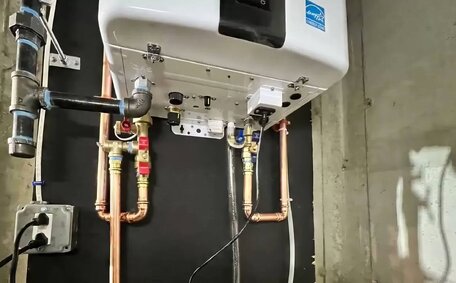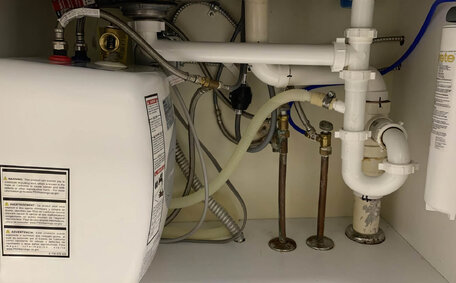Introduction to Hot Water System Warranties
Your water heater warranty safeguards a crucial household appliance. When purchasing a new hot water system, it’s crucial to understand what your water heater warranty terms specifically cover and the duration of coverage. Hot water heater warranties typically span 5-10 years, ensuring key components are protected under consumer guarantees as per Australian law.
To maintain valid coverage under your water heater warranty, ensure new installations are registered, fulfilling the essential guarantees mandated by Australian consumer law. Registering your installation solidifies your consumer rights, confirms insurance records, and is essential in case of policy cancellations or claims for foreseeable losses. Failing to register may forfeit entitlements to protections that are non-excludable under your warranty, in addition to statutory rights.
In the sections to follow, we’ll outline precisely what your hot water service warranty encompasses, the documentation required to file claims, reasons claims may be denied, and expert tips for smooth processing.
Locating Your Hot Water System Paperwork
To file a claim for your hot water system warranty, present the requisite documentation in line with the stipulated terms and conditions. Secure the following documents to support your claim if your water heater fails:
- Original invoice and receipt - This shows proof of purchase including the date, model details, serial number, and installation location.
- Warranty certificate - Usually provided upon registering the warranty, this outlines the terms and duration of coverage.
- Plumbing compliance certificate - Required for all new install water heater projects in Australia, this certifies it was fitted correctly.
- Service and repair records - Any documentation showing previous maintenance or repair attempts related to the issue.
Safeguard these documents as they are vital for warranty claims, ensuring protection under Australian consumer law. If you have lost any, contact the manufacturer, installer or plumber to request duplicates prior to lodging your claim.
Verifying Warranty Eligibility
Examine the original invoice to confirm warranty validity and product quality. Warranties generally last 5-10 years from the date of purchase, with specific components covered for varying lengths within this period.
Examine your warranty certificate to identify exactly what components of water heaters are covered under your specific warranty and for what duration. Key details to look for include:
- The overall warranty period for the entire system
- Separate coverage durations for the tank, heating elements, electronics, etc.
- Whether both parts labour are encompassed or solely parts
- Any exclusions or limitations to the warranty
Repair or replacement within the warranty period must comply with policies upholding your statutory rights. It’s imperative to adhere to the appropriate claims procedure, as the commitments ensuring goods fail acceptable quality guarantees cannot be disregarded and are essential to upholding your rights under the warranty.
Contacting the Original Installer
If your system experiences a significant quality failure, contacting the original installer for your warranty claim is an essential first step. The installation company that carried out the product service for you will possess thorough records, This information is pivotal, especially if the issue is a major one that concerns the model, serial number, and warranty duration.
Contact the original plumbing company immediately, especially in cases of major system failures:
- They can swiftly access all documentation relating to your system to assist your claim
- They installed the unit originally so understand maintenance history and any previous issues
- They can liaise directly with manufacturers as an authorised service if faults require investigation
- They will handle most of the claim process on your behalf
To commence the claim, locate the installer’s business name from your initial paperwork, such as invoices and receipts. If the installer is unreachable, make your claim following the procedures in your warranty documentation, particularly for major failures.
Gathering Details About Your System
Acquiring detailed information to understand your hot water system model is vital for lodging a warranty claim, particularly when the defect warrants a repair or replacement due to a major failure. This allows manufacturers to accurately assess warranty eligibility and identify potential faulty parts requiring repair replacement.
You can discover more about key information on your system in several places:
- The original sales receipt or invoice which should state the make, model number, serial number, and installation date.
- On the printed rating plate or sticker affixed to your gas water heater, showcasing the brand, model, serial number, specifications, capacity and additional details.
- Within your warranty registration paperwork that outlines the system particulars.
- On the compliance certificate provided during installation, noting make, model, serial number and installation specifics.
If accessing your system to find detail stickers is difficult, check inside any other maintenance panels. Manufacturers are required to display heater information on or inside access panels.
When lodging your claim, provide comprehensive system details such as make (e.g., Rheem hot water), model (e.g., Stellar 360), serial number, gas type, tank capacity, installation date and address.
Understanding Warranty Coverage
Standard warranties for hot water products provide coverage for faults and failures relating to parts and components, typically for around 6 years from the date of purchase and installation.
Key aspects that you can expect to be covered include the cost to repair water heater components:
- The stainless steel hot water tank and any internal elements
- Electrical control boards
- Valves and solar system fittings
- Any water heat pump circulation systems
- Thermostats and sensors
Most warranties encapsulate what the warranty does cover, including a broad labour warranty from the months date of purchase, aiding in addressing repair jobs when an acceptable quality failure does occur within that interval. Subsequent to this period, you’re usually expected to finance repair call-outs and servicing expenses, unless a provision to refund major failure equipment costs applies.
Review your warranty to understand its applicability, particularly regarding any foreseeable losses or damages, with reference to exceptions under Australian consumer law. Limitations often relate to aspects like water supply quality, deviations from advised installation instructions, inadequate maintenance, residential use, or environmental harm to the system. Utilising parts that are not genuine parts or services carried out by unauthorised technicians might lead to an increased energy bill and could risk invalidating parts of your coverage.
If faults are due to material or manufacturing defects within the warranty period, causing reasonably foreseeable loss, then the warranty is in force, and remedies via repair or goods come guarantees cannot be denied should be anticipated. Vigorously follow the correct claims procedures to secure compensation any potentially foreseeable loss or damage, guiding you towards the ideal resolution, particularly from damage caused by covered defects.
Filing a Warranty Claim
When you discover a fault with your hot water system that you believe should be covered under warranty, follow these key steps to lodge a claim:
- Collect all pertinent paperwork, including original receipts indicative of your purchase, warranty certificate, compliance certificate and any service history.
- Contact the original installation company if possible and provide system details like make, model and serial number.
- Check warranty eligibility criteria about duration and extent of coverage for the issue.
- Get in touch with the manufacturer via the contact details on your warranty paperwork.
- Explain the problem you are experiencing with as much supporting detail as possible.
- Respond to any requests from the manufacturer to diagnose the fault and determine warranty applicability.
- Wait for claim assessment after submitting all required paperwork and information.
- Post approval, you are also entitled goods repaired, or you may begin a replacement refund process with the manufacturer to arrange for the defective parts to be swapped out.
- Settle any expenses such as labour fees or costs for parts that extend beyond the warranty duration or refund the unused portion.
Pay close attention to warranty terms, including those stipulated by Australian consumer standards, so your claim isn’t jeopardised. Providing accurate information and abiding by the warranty’s terms, you are entitled to repairs as outlined in the warranty conditions.
Expected Timeframes for Repairs
After submitting a warranty claim for your hot water system, processing times may vary depending on the manufacturer. However, here is a general guide to standard timeframes under your product warranty:
- Initial claim review and eligibility confirmation – Usually within 5 to 10 business days.
- Diagnosis of faults by service technicians performing checks under approved conditions – Up to 2-3 weeks, subject to urgency and availability.
- Sourcing replacement parts from suppliers if under warranty – 2 weeks to 2 months depending on stock and shipping durations.
- Repair or installation of new components by manufacturer-approved plumbers – 1-5 days typically.
Keep in mind that public holidays, supply delays, and local service workloads can impact turnaround times. Complex cases requiring compensation for major failures may lead to extended timelines.
Where complex custom investigations are necessary or claim eligibility is unclear, resolutions may exceed this. Communication remains vital when dealing with goods services, so keep manufacturers updated on any changing circumstances that could affect your claim.
Manufacturers largely endeavour to make certain that goods, once goods are repaired or replaced should they not meet standards, are rectified swiftly in alignment with Australian warranty protocols. If you experience unreasonable delays or replaced goods don’t meet standards without sufficient explanation, you’re entitled to escalate the matter with management. Ultimately, persistently chasing progress remains key to smooth processing.
Common Reasons for Claim Denial
While reliable manufacturers generally honor warranties, certain faults may fall outside the coverage terms specified in Australian consumer law.
Common reasons a hot water system warranty claim may get denied include:
- Installation errors - In circumstances where systems endure major failures, aren’t installed according to manufacturer specifications, or are set up by non-professional technicians, warranty validity may be nullified.
- Water quality issues - Sediment buildup and corrosion from high mineral content water can lead to premature failures.
- Lack of maintenance - Failing to adequately service the system as per instructions makes breakages less likely to be covered.
- Parts or repairs by unauthorised agents - Engaging service providers who are non-approved or using components that aren’t genuine usually results in warranty invalidation.
- Environmental damages - Lightning strikes, floods, fires, freezes or similar events won’t be covered.
- General wear and tear - Gradual breakdown of components from regular use exceeds reasonable lifespans.
Despite being unfortunate, claim denials due to policy limitations, including some under Australian consumer law, do happen. Closely examining warranty terms, thoroughly reading the owner’s guide, and properly maintaining your system are critical actions.
To ensure the smoothest resolution of any foreseeable issues, contact the original installation company first when possible. Their expertise navigating often complex claims processes proves invaluable.
Tips for a Smooth Warranty Claim Process
Filing a warranty claim for your hot water system can feel daunting, but following these strategic tips will help ensure smooth processing:
- Carefully read all documentation to understand precisely what is and isn’t covered under your specific policy.
- Maintain detailed service and repair records as evidence if any issues emerge.
- Contact the original installation company first where possible to handle liaison and paperwork.
- Gather and provide comprehensive system details like make, model and serial numbers.
- Respond promptly to all requests from manufacturers to diagnose faults.
- Follow manufacturer instructions for appropriate use, care and maintenance.
- If delays extend beyond the expected timeframes, politely enquire about progress with higher management.
- Highlight supporting facts demonstrating faults resulted from defects rather than wear or misuse.
- Be patient but persistent in communicating about your claim if the process lags.
Mindful of warranty limitations, maintaining polite and clear communication is key to efficient claim resolution.






